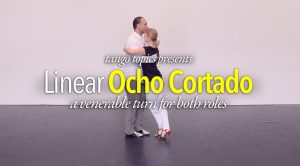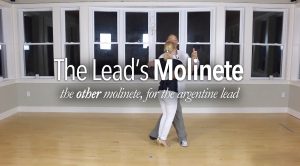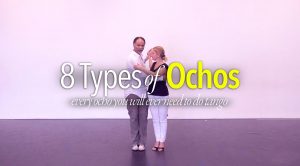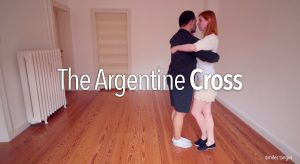The 5 Social Figures of Tango
There are Five Social FIgures of Argentine Tango > Walking, Ochos, Turns, Crosses, and Cortados. This site has all of them and more, over 800 videos and articles (not including all the other stuff) on Tango Topics to watch and learn from. It’s not just the videos, but the articles that contain the most of what you need to know to elevate your dance. We’re not trying to sell you videos here, but instead to inform and engage you to educate yourself wherever possible.

The Linear Ocho Cortado
What is a ‘Linear Ocho Cortado‘ ? The are multiple versions or ideas of the Cortado. However, this particular piece of vocabulary is also what we consider to be one of the Seven Foundational Moves of Tango that every dancer must learn in order to be a socially competent dancer. Note that we said, not ‘Lead‘, not ‘Follower’, but ‘Dancer’.

Circular Ocho Cortado
What is a ‘Circular’ Ocho Cortado ? Put simply it is leading the Follower to a Forward Ocho. However this is a very specific kind of Ocho that we only use for teaching purposes. In this particular case, that teaching Ocho is what’s sometimes called (and this site referred to as such) a ‘Linear Forward Ocho’. They’re called that because these ochos don’t go anywhere at all, and in fact they’re done directly in front of the Lead on a line. Hence the ‘Linear’ part of it’s name. 😉 The Lead invites the Follower to a Linear Forward Ocho across their body (to the open or closed side of the embrace, usually the closed side), and …

The Lead’s Molinete
What is a LEAD Molinete ? It is exactly as described, a Grapevine Turn that consists of an applied dissociative backstep, a ‘circular’ side step, and a dissociative forward step. That’s it. It doesn’t get any more complex than that. The only difference is that instead of the Follower doing this vocabulary, the Lead does it.

Eight Types of Turns
These are the eight, yes – EIGHT, types of Turns that are used in Argentine Tango. So what are those turns ? Read on to find out….

Eight Types of Ochos
What is an Ocho ? The Ocho is where the dancer (lead or follower) steps into Social Collection with their feet, and then assuming one of the 3 techniques above is used to generate bodily rotation that seemingly starts at the feet, and goes all the way up the body. Seemingly. 😉

Argentine Cross
What is The Argentine Cross ? In it’s simplest form, the ‘Cross‘, as it is known, is a distinct and unique piece of Tango vocabulary that doesn’t exist in any other social dance in this form. While there are ‘crosses’ in other social dances, there isn’t another cross like this anywhere else. What makes it unqiue ? For one, in this version of the cross, the Follower is a willing participant,

Ending A Dance
How Do We Want To End A Dance ? Answer: Simply. Nothing flashy, but very simple and plain which is to say: The way you start a dance is how we want to end a dance. If you started out facing each other, then you want to end up facing each other. How hard is that ?

Contortion
You see so many different ideas of dancing tango that it sometimes very hard to differentiate desirable from the undesirable. That unless you teach you’re not going to see these issues and need to be reminded of them, frequently so that you stop co-creating these less than desirable issues. ‘Contortion’ is twisting your body, then placing your body, and further still compressing (squeezing) your partner’s body into you, into a physiologically untenable position, and staying there for the length of a song. Then starting the next song in the tanda from a clean position, and then starting to slide into the contorted position. This is ‘Contortion’.

4 Social Dancing Tools
What are the ‘Four Social Dancing Tools’ ? First, what is a ‘tool’ as we’re defining it here ? A tool is a commonly used element that, and really it’s a transition from one thing to the next, that we use ubiquitously and don’t really pay a lot of attention to because it’s a stepping stone to the really cool thing we have in our minds. This is a tool. It’s the thing we use to make something else. Think of it as a Foundation, or a maker tool. A tool to make other things.
